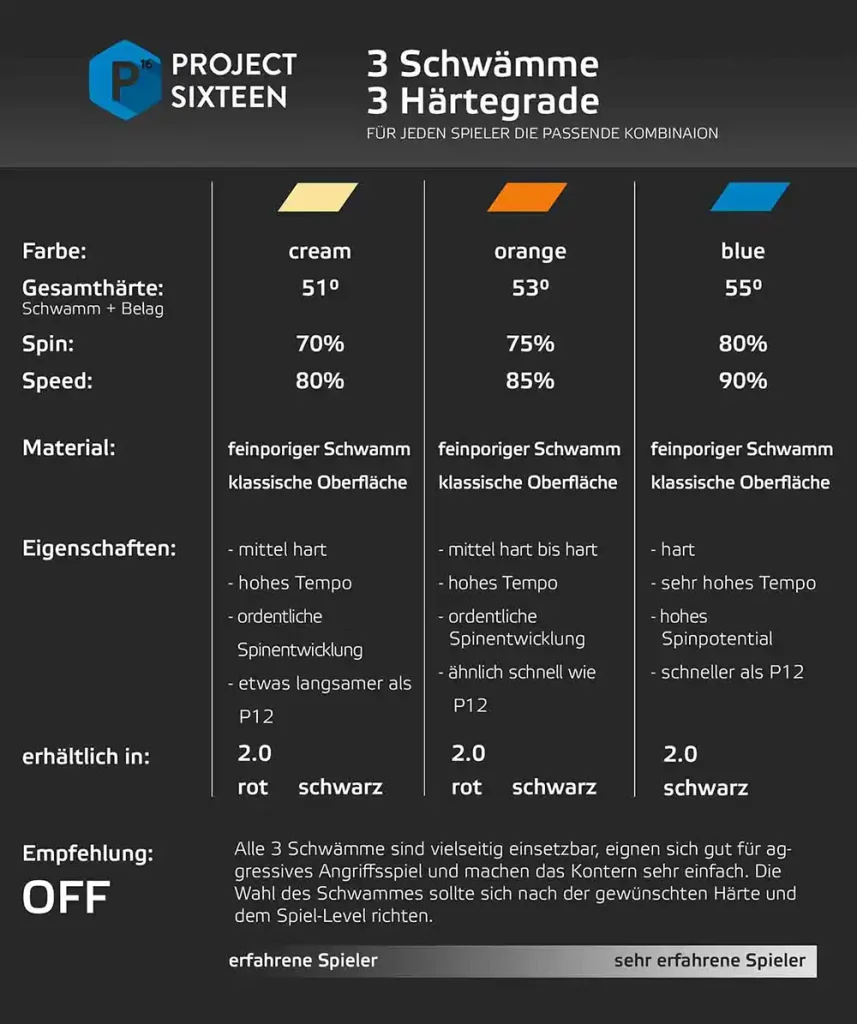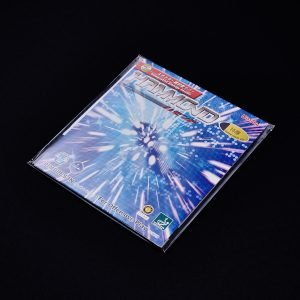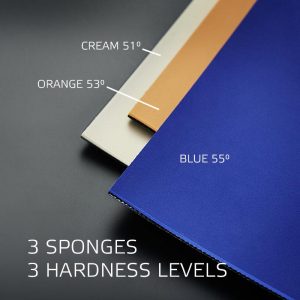Content:
- Which impact does hardness have on your game?
- What does the hardness level mean?
- Hard rubbers – advantages and disadvantages of hard table tennis rubbers
3.1 Which rubbers play hard? - Medium-hard rubbers – advantages and disadvantages of medium-hard table tennis rubbers
4.1 Which table tennis rubbers are medium-hard? - Soft rubbers – advantages and disadvantages of soft table tennis rubbers
5.1 Which table tennis rubbers are soft? - Conclusion
- Select the coating hardness level yourself
7.1 Comparison different hardness levels of P16
What influence does the hardness of a table tennis rubber have on your game?
Table tennis rubbers are available in different degrees of hardness. From soft to extremely hard.
We are often asked what is better – a hard or soft table tennis rubber?
Of course, there is no general answer to this question, as it is often a question of preference and training level.
To give you an overview, we’ve described the differences between the various hardness levels in a little more detail here.

Table tennis rubber hardness – what does it say?
The hardness of a table tennis rubber is given in degrees.
approx. 48 – 60° = hard table tennis surface
approx. 38 – 47° = medium-hard surface
to approx. 37° = soft surface
These values only indicate the hardness of the sponge without the top rubber. This is how many manufacturers do it.
For our own rubbers, we always state the total hardness, i.e. sponge + top rubber. Simply because we think it makes more sense and is more meaningful. From our point of view, the sponge and rubber count as a unit .
So please pay close attention to what the hardness ratings refer to. Unfortunately, there is no uniform solution for this yet, which can make a direct comparison somewhat difficult.
The playing characteristics of a rubber depend, among other things, on the hardness of the sponge used
A hard sponge is compressed less than a softer sponge when the ball hits it. How much the sponge is compressed when the ball bounces affects the ball contact time and the bounce of the ball.


The more the sponge is compressed, the longer the ball has contact with the rubber. Accordingly, you as a player have more time to influence the ball in terms of direction, speed and spin. At the same time, this compression makes the rubber less precise and reduces the speed.
Table tennis rubber hardness – hard
Advantages and disadvantages of hard table tennis rubbers
approx. 48 – 60°
Table tennis rubbers with hard sponge are perfect for spin generation and high rotation speeds.
Hard table tennis rubbers usually have little catapult and are therefore easier to control in short-short play. The balls are not catapulted out of the rubber as much and are easier to control. Short strokes are also easier to play with hard rubbers. Hard table tennis rubbers are generally easy to calculate in all game situations.
However, to fully exploit the potential of rubbers with hard sponge, you need a lot of training and conditioning. You have to work with strong arm pull and a lot of footwork and always stand right to the ball.
Hard coatings are therefore not necessarily recommended for beginners. However, if you master the use of harder table tennis rubbers, you can get the most potential out of them.
The harder the rubber, the more power it has. Higher rotation speeds can be played. However, as any table tennis rubber becomes harder, it also becomes harder to play. It is not for nothing that table tennis professionals mostly play rubbers with hard sponges.
Advantages
- well suited for short-short game
- well suited for short specifications
- little catapult, therefore to place precisely
- greatest potential in terms of speed and spin, if you master the technique
Disadvantages
- a lot of training and condition necessary to also use the potential
- not suitable for beginners
Which Table Tennis rubbers have a hard sponge?
These rubbers play hard and are suitable for offensive players only.
Table tennis rubber hardness – medium hard
Advantages and disadvantages of medium hard table tennis rubbers
approx. 38 – 47°
Table tennis rubbers with medium hard sponge are mainly designed for varied offensive play.
They have a longer ball contact time than harder rubbers because the ball can compress the sponge more at impact. The longer ball contact makes them a little easier to control and more forgiving of mistakes.
Table Tennis rubbers with medium hard sponge often come with a high catapult level. This has the advantage that you can get a lot of speed into the ball even with less arm pull and footwork.
The disadvantage of the catapult effect is that these rubbers do not accelerate linearly and are therefore somewhat unpredictable in some game situations. You never exactly now how the ball jumps off the rubber.
So if you can or want to work a little less with arm pull and footwork, you can use the catapult effect and still get some serious speed into your game.
A Table Tennis rubber with high catapult is the Hammond Z2 by Nittaku.
Advantages
- Less arm pull and leg work needed to generate speed
- longer ball contact time provides more control
- often higher catapult
Disadvantages
- Catapult effect makes the balls sometimes a little unpredictable
Which Table Tennis rubbers are medium hard?
medium hard rubbers for offensive and allround players
Table tennis rubber hardness – soft
Advantages and disadvantages of soft table tennis rubbers
up to approx. 37
Table Tennis rubbers with a soft sponge have the longest ball contact time. They are perfect for playing topspins. Thanks to the long ball contact you can easily bring rotation to the ball. In terms of speed soft rubbers are slower than hard rubbers. In return, they bring more control to the game and provide more security. They are therefore ideal for players who lack confidence at high speeds. Or who generally don’t want to play at too high a speed.
With soft rubbers you have the best control, at least with soft topspin and soft undercut balls.
Disadvantage of soft rubbers: However, if you hit the ball too hard with soft table tennis rubbers, the balls quickly become difficult to control. The reason for this is that the soft sponge is fully compressed on impact, causing the ball to be catapulted out of the rubber in an uncontrolled manner. The balls don’t jump off as precise as with hard sponges.
Advantages
- long ball contact time
- easy topspins
- well suited for soft topspins and undercut balls
- more control with soft strokes
- high catapult
Disadvantages
- Less speed
- high catapult sometimes provides unpredictable balls
- less precise than harder rubbers
Which Table Tennis rubbers play soft?
Soft rubbers are ideal for topspin play at moderate speed
Conclusion
Table tennis rubbers also need to be tried out and tested to see which degree of hardness best suits one’s own game. Generally speaking, the more skilled you are, the harder rubbers you can play. If you like to play rubbers with high catapult, you should go for soft to medium hard rubbers.
Table tennis rubber hardness choose yourself
As you can see, even small differences in sponge hardness can have a big effect on the playing characteristics. This is also the reason why we offer our two own rubbers, the P16 and P16ST, in three different sponge hardnesses. So you have the option to choose the sponge to match your style.
All 3 sponges are classified as medium hard to very hard. The cream-colored sponge is the softest, the blue sponge the hardest.
Cream-colored sponge = medium hard
Orange = hard
Blue = very hard
Comparison of hardness grades for table tennis rubber P16

You can choose the degree of hardness of these two rubbers yourself. They are each available with a soft (cream), medium-hard (orange) and hard sponge (blue).
We hope we could support you a little bit in choosing the right degree of hardness. If you have any question feel free to write us an Email.




















